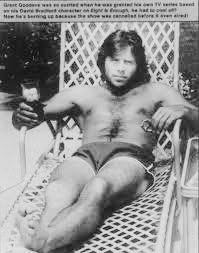Two boys together clinging, one the other never leaving....
In high school, I looked back on those moments of perfect happiness, and tried to get my hands on the Harvey Comics I read all those years ago (actually less than 10 years ago, but when you're 16, it seems like an eternity).
So I put an ad in the Rock Island Argus, and a very cute Augustana student named Clay answered with an offer of five Little Max comics from 1958-1959 for a dollar each.
I never heard of Little Max, they were from before I was born, and a dollar was four times what a comic cost on the newsstand. But I bought them anyway.
It was a weird type of deja vu, like looking at a photo of your parents before you were born: familiar, yet bizarre, with a story going on that you are not a part of and can't possibly understand. Readers were obviously expected to be familiar with these characters and their histories, but I had no idea who they were.
The star, Little Max, looks like Little Audrey in drag: he is drawn in the familiar Harvey style, cherubic-cute, with a big head and gigantic eyes. He doesn't speak, and his thought balloons are full of malapropisms that suggest a learning disorder: "They're both so kindly and generosity!"
 His mentor, chum, adopted father, or something is Joe Palooka, a tall, very muscular guy with a weird toothless grin. Max calls him "Dear Joe."
His mentor, chum, adopted father, or something is Joe Palooka, a tall, very muscular guy with a weird toothless grin. Max calls him "Dear Joe."Joe has also adopted or is mentoring an unnamed girl. Max calls her "Dear Her." "
She calls Max "Maxth" and Joe "Mith-ter Palooka."
In this Panel, she's looking at Max, not at Joe's swimsuit.

Most of adventures are slapstick, with Max trying to do a good deed that goes terribly wrong. Here he dresses at an Easter Bunny, is treed by a dog, and reflects on how "embarristing" it is to be "previously engagemented."
There are also fantasies, in which Joe reads Max a fairy tale, and he acts it out in his head, or Max writes his own version.
Sometimes Max appears a bit older, free to wander around without adult supervision. Although he still can't speak -- or use American Sign Language -- he makes himself understood adequately to interact with a group of friends.
Lots of stories are set on the beach, where Joe can wear a swimsuit and show off his physique, and Max can engage in some heroics (and, here, demonstrate a feminine limp wrist).
Other than the bizarre familiarity, I was attracted to the character of Max, heroic yet not macho, feminine yet never called a sissy.
And Joe Palooka, a single man who had adopted two children, but didn't have a wife or girlfriend.
I've done research since:
Joe Palooka was a naive immigrant boxer in a comic strip by Hal Fischer that premiered in 1921. He was immensely popular, spinning off into movies, a radio series, Big-Little Books, toys, games, and comic books. He was less popular by the 1950s, when his Harvey comic book series began, but Harvey in that era adapted several aging comic strip properties, including Terry and the Pirates and Blondie.
Little Max was a supporting character in the Palooka comic strip, a mute shoe-shine boy who Joe befriended. He had his own comic book series from 1949 to 1961.
And I discovered the origin of Little Max: Max Bartikowsky, a boy artist Hal Fischer knew during his childhood, who roamed around town in his mother's floppy hat. He became Big Max, owner of Bartikowsky Jewelry in downtown Wilkes-Barre, Pennsylvania.
He never married.
See also: Joe Palooka



















